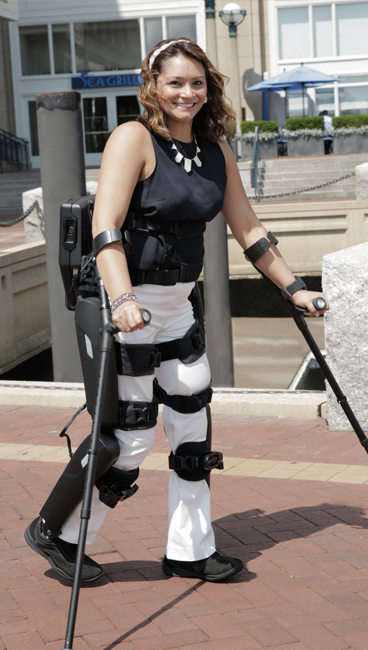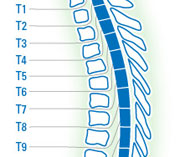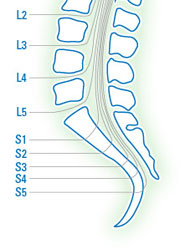Exoskeletons
Step-by-step, exoskeletons are making their way into the homes of thousands of paralyzed persons around the world. The transition from research labs to everyday use in the US is becoming a reality thanks to companies like ReWalk and there FDA approved exoskeleton. ReWalk is taking the lead both technologically and on a policy level to make these devices functional, affordable and in some instances insurance reimbursable. Below is a paper by Larry E. Miller, PhD (Miller Scientific Consulting, Inc., Asheville,NC) on three studies supporting how exoskeletons can make a beneficial impact on a paralyzed person’s everyday life.
For a more in depth 26-page paper outlining the medical benefits that come with using an exoskeleton on a daily basis, click here.
Evaluation of the ReWalk Computerized Exoskeleton for Patients with Spinal Cord Injury in Community Settings
Introduction
The inability to ambulate has profound negative consequences on the physical health and quality of life of individuals with spinal cord injury (SCI). These individuals suffer from osteoporosis, cardiovascular disease, respiratory problems, pressure ulcers, and muscular spasticity with a much higher frequency than the general population [1,2]. Besides the obvious physical and psychological toll of SCI, the resulting economic impact of SCI-related comorbidities is substantial. Approximately 30% of spinal cord-injured adults require hospital admission each year, with an average duration of 23 days per stay [3]. Average direct costs are $523,000 in the first year following injury and $80,000 in each subsequent year, accounting for over $3 million over the lifespan of a patient [4]. While SCI is irreversible in most cases, the associated physical deterioration can be mitigated with modest volumes of assisted ambulation. Yet, the typical SCI patient engages in only 40% of the activity levels of able-bodies peers, which is insufficient to yield meaningful health benefits [5]. Rehabilitative measures aimed at safely improving independence and ambulatory ability of spinal cord-injured adults are needed to offset the inevitable post-injury physical decline and associated economic burden.
In order to address this unmet healthcare need in the SCI population, orthotic technologies such as hip-knee-ankle-foot orthoses and reciprocating gait orthoses have been employed to encourage assisted ambulation. Unfortunately, compliance with these devices is generally poor since the high metabolic demand required to ambulate induces early fatigue [6-9]. Functional electric stimulation-assisted exercise is a promising treatment modality; however, these devices are primarily limited to stationary, non-weight bearing ergometry. Overall, currently available rehabilitative devices have limited utility in offsetting the medical complications from SCI since the greatest health benefits are realized from weight-bearing activities performed for moderate durations [10].
Powered exoskeletons are external motorized orthoses that facilitate standing, walking, and activities of daily living in real-world settings at sufficient intensity and duration for SCI patients to derive health benefits [11]. The ReWalk system (ReWalk Robotics Inc., Marlborough, MA, USA) is one of two powered exoskeletons currently cleared by the US Food and Drug Administration (FDA) for personal use at home and in the community. The purpose of this paper is to summarize results of three retrospective studies that assessed the feasibility of exoskeleton-assisted ambulation with the ReWalk system in patients with SCI in community settings.
RETROSPECTIVE STUDIES WITH THE REWALK COMPUTERIZED EXOSKELETON IN HOME AND COMMUNITY SETTINGS
Study 1: CLN0001
Objective
The objective of this study was to characterize the types of surfaces and environments used for ambulation in users of the ReWalk exoskeleton.
Methods
Eligible participants were spinal cord injured adults who completed training at an authorized rehabilitation center and, in the opinion of a therapist, were qualified to use the ReWalk exoskeleton in a community ambulation setting. Users were selected to represent the typical range of injury levels, sex, and body types of spinal cord-injured adults. A total of 10 sessions for each user was recorded. At completion of the training sessions, a trained investigator interviewed each patient regarding the surfaces they walked on and the environments in which they walked, such as interior surfaces, doors, exterior surfaces, terrain, and environments. Subjects were asked to describe 10 sessions in which they used the ReWalk in situations that were representative of community ambulation.
Results
A total of 6 users were interviewed regarding a total of 60 exoskeleton sessions (10 sessions per patient). Patient characteristics are reported in Table 1.
Table 1. Baseline patient characteristics.
|
Characteristic |
Subject ID |
|||||
|
CL1 |
IN2 |
RA3 |
AN4 |
AG5 |
DA6 |
|
|
Age |
33 |
27 |
43 |
41 |
38 |
43 |
|
Sex |
Female |
Female |
Male |
Male |
Female |
Male |
|
Level of injury |
T4 |
T6 |
T8 |
T8 |
T12-L3 |
T9 |
|
ASIA class |
A |
B |
A |
A |
A |
B |
|
Year of spinal cord injury |
2007 |
1987 |
1988 |
2004 |
2004 |
2010 |
|
Duration of ReWalk use (yr) |
1.8 |
0.7 |
4.0 |
1.3 |
3.5 |
2.0 |
Interior walking was categorized by types of surfaces and the ability to negotiate doors, both ADA compliant and other types of doors. All subjects walked on both tile and carpeted surfaces. The wood surfaces were walked on by 5 subjects and granite surfaces by 3 subjects. Exoskeleton users walked over door thresholds in 63% of sessions. The users also used ADA doors in 43% of sessions.
Regarding exterior surfaces, all subjects walked on concrete or asphalt surfaces while using the ReWalk outside a building, representing 72% of total sessions. Five of 6 users reported walking on grass and 4 of 6 reported walking on gravel surfaces. Half of the subjects reported on walking on wet surfaces.
Most of the terrain features the users were asked about wee related to using the ReWalk in exterior situations. These included curbs, sidewalks, streets, crossing streets, and driveways. All subjects could negotiate at least some of the identified terrain. In addition, all subjects could navigate ramps. Most subjects (5 of 6) also used an elevator at least once with the ReWalk.
Community locations constituted the majority of the uses, with 52% of sessions performed in busy environments. All users reported having a companion each time they used the ReWalk. All subjects could function without any assistance in some situations. Four patients completed all sessions with no assistance and 2 patients performed sessions with either no assistance or minimal contact. Of the 60 total sessions, no falls or serious adverse events were reported in any ReWalk user.
Discussion
Among 60 separate sessions with the ReWalk in experienced users, the entire range of surfaces and environments that comprised what a user would typically experience during community ambulation was documented. Throughout this experience, no falls or complications were reported and all users developed sufficient proficiency with the ReWalk to be able to use the device in community ambulation situations. Specifically, 38% of training sessions involved crossing a street, 83% of sessions occurred outside the home, and 52% of sessions occurred in situations that were described as busy. Overall, these self-reported experiences from spinal cord injured adults demonstrated that the ReWalk device could be safely used for community ambulation.
Study 2: CLN0002
Objective
The objective of this study was to determine whether spinal cord injured patients could learn to use the ReWalk while training at a rehabilitation center with sufficient skills to allow safe use in a community ambulation setting.
Methods
All subjects in this study had been trained at the University of Oklahoma Health Sciences Center on the use of the ReWalk system. The lead physical therapist contacted all subjects who had trained using the ReWalk. Patient records were reviewed to determine what skills / activities were performed at each training session, including basic use skills, knowledge of the device, safety features and application of these skills in a range of environments that were representative of what a user would encounter in community ambulation. Each training session occurred in an environment representative of a challenging community ambulation setting.
Results
A total of 5 users underwent a total of 186 sessions (mean: 37 sessions per patient). Patient characteristics are reported in Table 1.
Table 1. Baseline patient characteristics.
|
Characteristic |
Subject ID |
||||
|
WW |
SJ |
SW |
PJ |
AM |
|
|
Age |
38 |
24 |
20 |
25 |
49 |
|
Sex |
Male |
Female |
Female |
Male |
Male |
|
Level of injury |
T8 |
L2 |
T10 |
T6 |
T8 |
|
Duration of ReWalk use (yr) |
1.2 |
0.5 |
0.7 |
1.2 |
1.0 |
All subjects demonstrated the ability to perform the basic skills of donning the system, rising from a chair, standing, walking, (turning left, right and reversing direction) and 5 of 6 could sit back in the chair (data were missing for 1 patient). All subjects were capable of walking at a speed of at least 0.15 meters per second.
A 10-meter walk evaluation was performed on both interior and exterior surfaces. The interior surfaces consisted of tile or mild irregular surfaces. Two subjects walked on the tile surface and three walked on the mild irregular surface. Exterior surfaces were either concrete or grass. Two subjects reported walking on concrete and three reported walking on grass. In 4 patients, a 6-minute walk was completed on concrete or grass surfaces.
Subjects were evaluated on ability to negotiate interior and exterior terrains. Interior terrain consisted of negotiating ADA compliant doors, manual doors, and using an elevator. All subjects could use the ReWalk in these situations. Exterior terrain consisted of walking on a ramp, negotiating a curb, and crossing a street with a traffic light for pedestrians; 4 of 5 subjects could use the ReWalk in these situations. Of the 186 total sessions, no falls or serious adverse events were reported in any ReWalk user.
Discussion
Patients who were trained at the Oklahoma University Health Science Center were able to safely ambulate in the ReWalk device. In the process of learning to walk, these patients mastered a series of basic skills including rising from a chair, walking, turning, stopping and sitting. These skills are required for using the device in a community ambulation setting. In addition, they also could learn and apply these skills in a challenging environment, a multi-use academic building. In this environment, they were able to learn the advanced skills necessary for community ambulation, interior and exterior terrain, and a variety of walking surfaces (tile, concrete and grass). Overall, these results demonstrate that the ReWalk device could be safely used for community ambulation.
Study 3: CLN10531
Objective
The objective of this retrospective analysis of the ReWalk clinical study data was to document the surfaces walked on using the ReWalk system during the course of a rehabilitation medicine study.
Methods
Two clinical studies of the ReWalk exoskeleton were performed. A study performed at the Sheba Medical Center in Tel-Hashomer, Israel and a multicenter study performed at Albert Einstein Medical Center, Moss Rehabilitation Center, Elkins Park, Pennsylvania, USA and Ospedale Valduce di Como, Centro Villa Beretta, Italy.
At each of these sites, part of the standard training protocol had the subject walk through the hospital on a variety of surfaces and eventually walk outside. At other times, the subjects would cover a prescribed course through and around the institution that covered many of the surfaces of interest. The interior surfaces were either smooth or carpeted. The smooth surfaces may have included linoleum, tile, or wood. The carpeted surfaces were typically industrial or non-shag construction. The exterior surfaces included hard surfaces such as concrete or asphalt, and grass.
Results
A total of 37 users underwent a total of 708 sessions (mean: 20 sessions per patient). Most (71%) sessions were performed on smooth surfaces, 29% on carpet, 14% on concrete/asphalt, 4% on carpet, and 3% on grass. Of the 28 patients with reported data, 5 navigated ramps and 3 navigated curb cutouts.
Discussion
Among 708 separate sessions with the ReWalk in spinal cord injured adults, the entire range of surfaces and environments that comprise what a user would typically experience during community ambulation was documented. While most sessions were conducted on smooth surfaces, 15 of 37 users utilized the exoskeleton in more challenging settings such as uneven surfaces or ramps. Overall, these self-reported experiences from spinal cord injured adults demonstrate proficient use of the ReWalk device in community ambulation settings.
CONCLUSION
Spinal cord injury is responsible for significant lifelong loss of functional ability, frequent secondary complications, and tremendous costs to the healthcare system. Routine physical activity reduces the physical and economic burden of SCI. Widespread clinical adoption of new technologies that safely facilitate ambulation for SCI patients in the home and community settings would yield significant cost savings. Powered exoskeletons enable SCI patients to perform fundamental activities such as standing and walking at home or in a community setting. Furthermore, patients can ambulate faster and with less effort using a powered exoskeleton vs. hip-knee-ankle-foot orthoses and reciprocating gait orthoses. In this series of studies, we summarized experiences of 48 spinal cord injured adults among 954 sessions with the ReWalk exoskeleton. The collective results of these studies demonstrate that the ReWalk exoskeleton allows for safe ambulation in spinal cord injured adults across a wide variety of settings, including challenging community environments.
REFERENCES
[1] Jensen MP, Truitt AR, Schomer KG, Yorkston KM, Baylor C, Molton IR. Frequency and age effects of secondary health conditions in individuals with spinal cord injury: a scoping review. Spinal Cord 2013;51:882-92.
[2] Sezer N, Akkus S, Ugurlu FG. Chronic complications of spinal cord injury. World J Orthop 2015;6:24-33.
[3] Facts and Figures at a Glance. Birmingham, AL: National Spinal Cord Injury Statistical Center; February 2014.
[4] DeVivo MJ, Chen Y, Mennemeyer ST, Deutsch A. Costs of care following spinal cord injury. Topics in Spinal Cord Injury and Rehabilitation 2011;16:1-9.
[5] van den Berg-Emons RJ, Bussmann JB, Stam HJ. Accelerometry-based activity spectrum in persons with chronic physical conditions. Arch Phys Med Rehabil 2010;91:1856-61.
[6] Bernardi M, Canale I, Castellano V, Di Filippo L, Felici F, Marchetti M. The efficiency of walking of paraplegic patients using a reciprocating gait orthosis. Paraplegia 1995;33:409-15.
[7] Scivoletto G, Petrelli A, Lucente LD, Giannantoni A, Fuoco U, D’Ambrosio F, Filippini V. One year follow up of spinal cord injury patients using a reciprocating gait orthosis: preliminary report. Spinal Cord 2000;38:555-8.
[8] Franceschini M, Baratta S, Zampolini M, Loria D, Lotta S. Reciprocating gait orthoses: a multicenter study of their use by spinal cord injured patients. Arch Phys Med Rehabil 1997;78:582-6.
[9] Sykes L, Edwards J, Powell ES, Ross ER. The reciprocating gait orthosis: long-term usage patterns. Arch Phys Med Rehabil 1995;76:779-83.
[10] Foulds HJ, Bredin SS, Charlesworth SA, Ivey AC, Warburton DE. Exercise volume and intensity: a dose-response relationship with health benefits. Eur J Appl Physiol 2014;114:1563-71.
[11] Miller LE, Zimmermann AK, Herbert WG. Clinical effectiveness and safety of powered exoskeleton-assisted walking in patients with spinal cord injury: systematic review with meta-analysis. Med Devices (Auckl) 2016;9:455-66.
[12] Spungen AM. 6/21/2016. The ReWalk Exoskeleton Walking System for Persons with Paraplegia (VA_ReWalk). National Library of Medicine (US) <https://www.clinicaltrials.gov/ct2/show/NCT01454570?term=Rewalk&rank=4>. 6/21/2016.
[13] Asselin P. Exoskeleton Assisted Walking: Training methods and mobility skills achieved. 2014 November 13-16, 2014; San Diego, CA.
[14] Fineberg DB, Asselin P, Harel NY, Agranova-Breyter I, Kornfeld SD, Bauman WA, Spungen AM. Vertical ground reaction force-based analysis of powered exoskeleton-assisted walking in persons with motor-complete paraplegia. J Spinal Cord Med 2013;36:313-21.
[15] Harel NY, Asselin PK, Knezevic S, Kornfeld SD, Spungen AM. Exoskeleton walking improves seated balance in chronic SCI. 2014 November 13-16, 2014; San Diego, CA.
[16] Arazpour M, Bani MA, Hutchins SW, Jones RK. The physiological cost index of walking with mechanical and powered gait orthosis in patients with spinal cord injury. Spinal Cord 2013;51:356-9.












